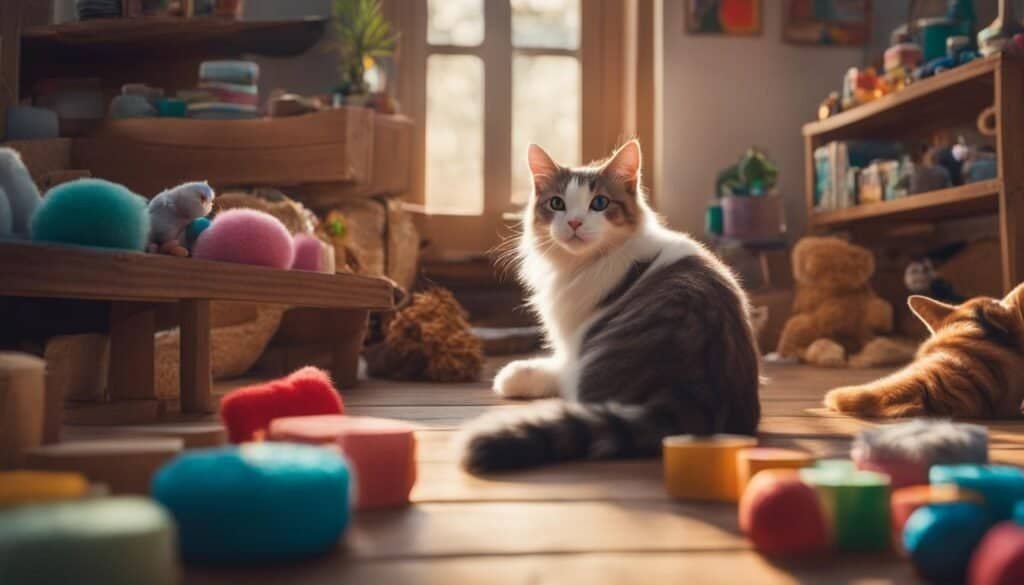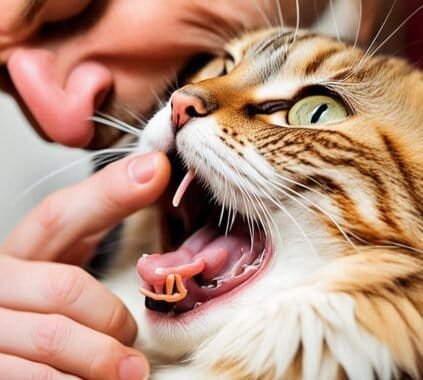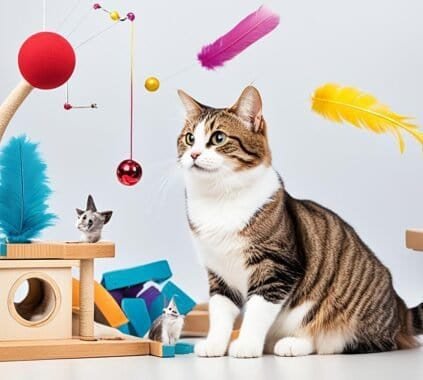Studies have shown that cats can experience anxiety and stress, just like humans. Cat anxiety and stress can manifest in various ways, from physical reactions to behavioral changes. It is essential for cat owners to recognize the signs of anxiety in their feline companions to provide them with proper care and support.
Some common signs of cat anxiety include increased heart and respiratory rates, hiding, excessive vocalization, and destructive behavior. These symptoms can be distressing for both cats and their owners. Understanding the causes and implementing effective treatment strategies are crucial in improving the well-being of anxious cats.
There are several possible causes of cat anxiety, including illness or physical pain, traumatic experiences, improper socialization, and separation anxiety. Identifying the underlying cause is essential in developing an appropriate treatment plan.
Treatment for cat anxiety often involves a combination of environmental management, medications, and behavior modification. Creating a stress-free and structured environment, providing calming products and natural remedies, and working with veterinarians to find suitable medications are some approaches that can help relieve cat anxiety.
It is important to note that punishing an anxious cat or confining them can escalate their fear and worsen their anxiety. Instead, comforting and reassuring them in a safe space can provide them with the support they need.
Remember, each cat is unique, and the prognosis for cat anxiety can vary. With proper care, understanding, and professional guidance, cat owners can help their furry friends lead happier and more serene lives, free from excessive stress and anxiety.
Key Takeaways:
- Recognize the signs of cat anxiety, such as increased heart and respiratory rates, hiding, excessive vocalization, and destructive behavior.
- Common causes of cat anxiety include illness or physical pain, traumatic experiences, improper socialization, and separation anxiety.
- Treatment for cat anxiety may involve environmental management, use of calming products and natural remedies, medications, and behavior modification.
- Comfort and reassurance are important when dealing with an anxious cat. Avoid punishment and confining them in stressful situations.
- Each cat is unique, and the prognosis for cat anxiety can vary. Seek professional guidance to develop an appropriate treatment plan for your cat.
Signs of Cat Anxiety and Stress
Cat anxiety can manifest in various ways, ranging from mild to severe. Recognizing the signs of cat anxiety is crucial for identifying and addressing your pet’s emotional well-being. Here are some common signs to watch for:
Mild Signs of Cat Anxiety
- Avoiding eye contact
- Holding their tail close to their body
- Partially dilated pupils
Moderate Signs of Cat Anxiety
- Increased respiratory rate
- Tightened tail against the body
- Crouching
Severe Signs of Cat Anxiety
- Freezing in place
- Fully dilated pupils
- Aggressive behavior
- Hair standing up
These signs may indicate varying levels of anxiety in cats. If you observe any of these behaviors consistently, it’s important to consult a veterinarian or a professional behaviorist to understand and address your cat’s anxiety.
What to Do When Your Cat Is Anxious or Scared
When your cat is experiencing anxiety or fear, it is essential to provide comfort and reassurance. Punishing a scared cat can exacerbate their fear and lead to aggressive behavior. Additionally, attempting to confine an anxious cat, such as placing them in a carrier, can further escalate their anxiety and panic.
Instead, focus on creating a calm and safe environment for your cat. Allow them to seek comfort in a designated space where they feel secure. Provide cozy bedding, familiar scents, and soothing music to help them relax.
Comforting your cat through gentle petting, soft voices, and calming body language can also help alleviate their anxiety. Try to maintain a calm and relaxed demeanor to reassure them that they are safe.
Additionally, consider using pheromone diffusers or sprays specifically designed to reduce cat anxiety. These products release synthetic pheromones that mimic the calming scents naturally produced by cats, creating a sense of security and well-being.
Quotes:
A scared cat needs understanding, comfort, and patience, not punishment.
Remember, punishing a scared cat will only increase their anxiety and may lead to long-term behavioral issues. By providing comfort and creating a peaceful environment, you can help your cat navigate their anxiety and feel secure.
Creating a safe and calm space for your anxious cat is crucial in helping them overcome their fears and anxiety.
Causes of Cat Anxiety
There are several potential causes of cat anxiety that can contribute to the development or exacerbation of anxieties. Identifying the underlying cause is important in developing an appropriate treatment plan for your furry friend.
Illness or Physical Pain
Illness or physical pain can be a significant cause of cat anxiety. When cats are experiencing discomfort or pain, it can lead to heightened stress levels and anxious behaviors. It is important to consult with a veterinarian to rule out any underlying medical conditions that may be contributing to your cat’s anxiety.
Trauma
Traumatic experiences can trigger fear and anxiety in cats. These experiences can range from loud noises, such as fireworks or thunderstorms, to more severe situations like accidents or abuse. Cats may develop anxiety as a result of past traumas, causing them to display fearful behaviors or react negatively in certain situations.
Improper Socialization
Proper socialization during the critical period of 7 to 12 weeks of age is crucial for cats. If a cat has not been exposed to various people, animals, and environments during this time, they may develop habitual fear or anxiety. Cats that have not been properly socialized may exhibit anxious behaviors when faced with new or unfamiliar situations.
Separation Anxiety
Separation anxiety is another common cause of anxiety in cats. Cats are known for forming strong bonds with their owners, and being separated from their human companions can cause distress. Separation anxiety can be triggered by factors such as rehoming, noise phobia, or being abandoned. Cats with separation anxiety may exhibit destructive behaviors, excessive vocalization, and excessive grooming when left alone.
Understanding the causes of your cat’s anxiety is an important step towards developing an effective treatment plan. By addressing the underlying causes, you can help your cat overcome their anxiety and improve their overall well-being.

How Do Vets Determine the Cause of Cat Anxiety?
To accurately diagnose the cause of cat anxiety, veterinarians employ a combination of medical and behavioral assessments. The first step is conducting a thorough examination to rule out any underlying medical conditions that may be contributing to the behavior. This includes blood tests, urine tests, and additional diagnostic tests as needed.
A comprehensive behavioral history is also essential in understanding the cat’s anxiety. Vets will gather information about the cat’s past experiences, environment, and interactions with household members or other animals. Observing the cat’s reactions to specific triggers can provide valuable insights.
In some cases, videos of the cat’s behavior may be requested to assist in the diagnosis. This visual evidence allows the vet to observe the cat’s anxiety-related behaviors firsthand.
“By combining medical tests, behavioral history, and observations, veterinarians can accurately diagnose the underlying cause of cat anxiety.”
Veterinarians follow a systematic approach that prioritizes ruling out medical conditions before focusing on behavioral causes. This comprehensive diagnostic process enables them to form an accurate understanding of the cause and develop an appropriate treatment plan.
Medical Tests for Cat Anxiety Diagnosis
- Blood tests: Analyzing the cat’s blood can help identify any imbalances, abnormalities, or underlying health issues that may be contributing to anxiety.
- Urine tests: Examining the cat’s urine can provide additional insights into the presence of any medical conditions and help determine if they are contributing to anxiety.
- Additional diagnostic tests: Depending on the specific symptoms and medical history, veterinarians may recommend other tests, such as X-rays or ultrasounds, to further investigate potential underlying causes.
By conducting these tests, veterinarians can eliminate or identify any medical conditions that may be triggering or exacerbating cat anxiety.
In this section, we will discuss how veterinarians determine the cause of cat anxiety through a combination of medical tests, behavioral history analysis, and observations of the cat’s reactions to triggers. This comprehensive approach allows for an accurate diagnosis, enabling the development of an appropriate treatment plan.
To begin the diagnostic process, veterinarians perform a thorough examination to rule out any underlying medical conditions that may contribute to the cat’s anxiety. This includes blood tests, urine tests, and additional diagnostic tests as needed. These medical tests help identify any imbalances or abnormalities that may be causing or exacerbating the anxiety.
In addition to medical tests, veterinarians gather a comprehensive behavioral history of the cat. This includes information about the cat’s past experiences, environment, and interactions with household members or other animals. Understanding the cat’s behavioral history provides valuable insights into potential triggers and stressors.
Observing the cat’s reactions to specific triggers is another important aspect of the diagnostic process. By observing the cat’s behavior in different situations, veterinarians can identify patterns and determine what triggers anxiety in the cat. In some cases, videos of the cat’s behavior may be requested to provide visual evidence of anxiety-related behaviors.
By combining medical tests, behavioral history, and observations, veterinarians can accurately diagnose the underlying cause of cat anxiety. This allows for the development of an appropriate treatment plan tailored to the individual cat. The diagnostic process ensures that any underlying medical conditions are addressed and that behavioral factors are taken into account when managing the cat’s anxiety.
How Do You Treat Anxiety in Cats?
Treatment for cat anxiety often involves a combination of environmental management, medications, and behavior modification. Creating a stress-free and structured environment for your cat can help manage the condition.
Medications, such as antidepressants, may be prescribed to reduce anxiety levels in cats. It’s important to regularly follow up with the veterinarian to monitor your cat’s response to the medication and adjust the dosage if needed.
Behavior modification techniques can significantly help in reducing cat anxiety. Desensitization involves gradual exposure to anxiety-inducing stimuli, allowing the cat to become more comfortable with them. Counterconditioning aims to change the cat’s negative emotional response to a particular stimulus by associating it with positive experiences.
Working closely with your veterinarian is essential in determining the best treatment approach for your cat based on their specific needs and symptoms.
Managing Cat Anxiety
Managing cat anxiety involves creating an environment that minimizes triggers and stressors for the cat. By understanding and addressing the specific needs of your anxious cat, you can effectively manage their anxiety and provide them with a peaceful and secure space.
One crucial aspect of managing cat anxiety is environmental management. This involves identifying and avoiding situations that cause fear or anxiety for your cat. For example, if your cat is afraid of loud noises such as fireworks or thunderstorms, create a safe and quiet space where they can retreat during these events. Providing hiding spots and using soundproofing measures can also help minimize exposure to stressful stimuli.
Protecting anxious cats involves creating a protected environment tailored to their needs. Ensure that your cat has a quiet, secluded area where they can retreat and feel safe when they are feeling anxious or stressed. This can be a cozy corner or a designated room with soft bedding and familiar toys. Consider using Feliway diffusers, which release calming pheromones, to create a soothing atmosphere for your cat.
In some cases, hospitalization may be necessary to ensure the cat’s safety and protection until medications take effect. This is particularly relevant if your cat’s anxiety is severe, and they require close monitoring and specialized care. Your veterinarian can advise you on whether hospitalization is needed and guide you through the process.

“Creating an environment that minimizes triggers and stressors is instrumental in managing cat anxiety,” explains Dr. Emily Rodriguez, a feline behavior specialist.
“By understanding your cat’s anxieties and providing a secure and protected space, you can help alleviate their stress and promote their overall well-being.”
By implementing effective environmental management and providing a protected environment, you can play a significant role in managing your cat’s anxiety. Remember that each cat is unique, and what works for one may not work for another. It is essential to observe your cat’s behaviors, listen to their needs, and adapt your approach accordingly.
Cat Anxiety Medicine
Cat anxiety medications, such as antidepressants, can be prescribed to help reduce anxiety levels in cats. These medications are designed to alleviate the symptoms of cat anxiety and promote a sense of calmness and well-being. It’s important to note that these medications generally take several weeks to work and may need to be continued for an extended period of time to maintain their effectiveness.
Antidepressants are commonly used in cats to treat anxiety disorders. These medications work by balancing the chemicals in the brain that regulate mood and emotions. They can help reduce anxiety and improve the overall behavior and quality of life in anxious cats. However, it’s crucial to follow veterinary guidance and recommendations when administering antidepressants to cats.
Short-acting medications are also available for specific events or situations that may trigger anxiety in cats. For example, during fireworks or veterinary visits, short-acting medications can be given to help alleviate anxiety temporarily and provide immediate relief for the cat. These medications are typically fast-acting and have a shorter duration of action compared to long-term medications.
Regular monitoring is essential when using cat anxiety medication. It’s important to track the cat’s progress, potential side effects, and the overall effectiveness of the prescribed treatment. Your veterinarian will guide you on the proper dosage and frequency of medication administration.
Combining medication with other treatment approaches, such as environmental management and behavior modification techniques, can further enhance the effectiveness of cat anxiety treatment. Working closely with your veterinarian will ensure the holistic well-being of your anxious feline companion.
- Antidepressants can be prescribed to reduce anxiety levels in cats.
- These medications may take several weeks to work and require long-term use.
- Short-acting medications are available for immediate relief during specific triggering events.
- Regular monitoring and following veterinary guidance are crucial when administering medication to cats.
- Combining medication with other treatment approaches can enhance effectiveness.
Behavior Modification to Relieve Cat Anxiety
When it comes to alleviating cat anxiety, behavior modification techniques can play a crucial role. Two commonly used methods are desensitization and counterconditioning, tailored to the specific needs of each individual cat. These techniques focus on gradually exposing the cat to anxiety-inducing stimuli and reshaping their emotional response.
Desensitization involves exposing the cat to the anxiety trigger in a controlled and gradual manner. Starting at a low level of exposure, such as a distant sound or sight, allows the cat to become more comfortable over time. By gradually increasing the intensity or proximity of the trigger, the cat can learn to tolerate and eventually overcome their anxiety.
Counterconditioning aims to change the cat’s emotional response to the anxiety trigger from negative to positive. This is achieved through associating the trigger with something enjoyable or rewarding, such as treats, playtime, or affection. By consistently pairing the trigger with positive experiences, the cat’s emotional association can shift, leading to a reduction in anxiety.
These behavior modification techniques require patience, consistency, and understanding of cat behavior. It is important to remember that every cat is unique and may respond differently to these methods. Seeking guidance from a veterinarian or a certified animal behaviorist can greatly enhance the success of behavior modification programs.
It is important to note that the prognosis for cat anxiety can vary depending on several factors. The individual cat’s personality, the severity of the anxiety, and the effectiveness of the treatment approach all play a role in determining the outcome. With proper care and a tailored behavior modification plan, many cats can experience significant improvement in their anxiety levels and overall well-being.
Preventing Newly Adopted Cats From Becoming Anxious
When adopting a new cat, it is essential to prioritize proper socialization and positive exposures to minimize the risk of developing anxiety. The socialization period for kittens typically ends around 7 weeks old, but socialization can still benefit cats up to 14 weeks old. By exposing your cat to a variety of social situations and environments in a positive and gradual manner, you can help reduce the likelihood of fearful behavior.
Avoid forcing your cat into stressful situations, as this can exacerbate anxiety. Instead, provide a safe and supportive environment for them to adjust and adapt. Encourage positive interactions with people and other animals, making sure they feel secure and loved.
Remember, patience is key when helping your newly adopted cat adjust. It may take time for them to feel comfortable in their new surroundings, so be understanding and supportive throughout the process.
Here are some tips for preventing cat anxiety in newly adopted cats:
- Gradual Introductions: Introduce your new cat to their new home gradually. Start with one room, then slowly allow access to other areas of the house. This helps them feel secure in each new space.
- Positive Exposures: Expose your cat to different sights, sounds, and smells in a positive way. This can include gentle handling, playtime, and exposure to household noises. Gradually introduce them to new experiences, such as car rides or visits to the veterinarian, to help them become more comfortable.
- Establish a Routine: Cats thrive on routine, so establish a consistent daily schedule for feeding, playtime, and relaxation. This helps provide a sense of security and predictability.
- Create Safe Spaces: Set up hiding places and cozy spots where your cat can retreat to when they feel overwhelmed or anxious. Ensure they have access to fresh water, a litter box, and comfortable bedding in these areas.
- Positive Reinforcement: Use positive reinforcement techniques, such as treats and praise, to reward your cat for calm and confident behavior. This helps reinforce positive associations and reduces anxiety.
Remember, each cat is unique, and it may take time for them to fully adjust. Providing a loving and supportive environment, along with patience and understanding, can go a long way in preventing cat anxiety and helping your newly adopted cat thrive.
Conclusion
Cat anxiety and stress can have a significant impact on a cat’s overall well-being and quality of life. It is important for cat owners to be able to recognize the signs of cat anxiety, such as increased heart and respiratory rates, hiding, excessive vocalization, and destruction. By understanding the underlying causes of cat anxiety, such as illness, trauma, or separation anxiety, cat owners can take appropriate steps to address these issues and provide relief for their anxious cats.
Managing cat anxiety involves a combination of environmental management, medications, and behavior modification techniques. Creating a stress-free environment for your cat, minimizing exposure to stressors, and providing comfort and reassurance can help alleviate anxiety in cats. In some cases, medications such as antidepressants may be prescribed to reduce anxiety levels. Behavior modification techniques like desensitization and counterconditioning can also be effective in helping cats overcome their anxieties.
It is important to remember that the prognosis for cat anxiety can vary depending on the individual cat and the severity of the anxiety. With proper care and understanding, however, cats can lead happier and more serene lives free from excessive stress and anxiety. Take the time to create a stress-free environment for your feline friend and seek professional guidance if needed. By managing cat anxiety effectively, you can ensure that your cat’s well-being and quality of life are maximized.
FAQ
What are the signs of cat anxiety?
How should I comfort my anxious or scared cat?
What are the potential causes of cat anxiety?
How do veterinarians determine the cause of cat anxiety?
How is cat anxiety treated?
How can I manage cat anxiety?
Are there medications for cat anxiety?
Can behavior modification techniques help relieve cat anxiety?
How can I prevent newly adopted cats from becoming anxious?
Last modified: February 20, 2024














[…] are several factors that can contribute to a cat’s excessive nocturnal activity. Understanding these factors can help cat owners better manage their furry companions’ nighttime […]
[…] cats have grooming needs similar to other cats. In this section, we will discuss important grooming tips for Sphynx cats to ensure their well-being and keep their skin in optimal […]
[…] diffusers can create a calming environment for cats and may help alleviate stress or anxiety that could be causing litter box refusal. These diffusers release synthetic pheromones that mimic […]
[…] a safe and positive environment. Avoid using punishment-based training methods, as they can cause stress and anxiety in this sensitive […]